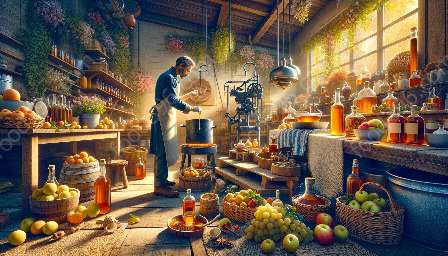Maple syrup is a beloved sweetener that has been produced for centuries. The process of making maple syrup involves tapping maple trees, collecting the sap, and boiling it down to create the rich, flavorful syrup that is enjoyed all over the world. In this topic cluster, we will explore the traditional and modern production methods for maple syrup, as well as its significance in food preservation and processing.
The Process of Syrup Production
Tapping Maple Trees
The production of maple syrup begins with the tapping of maple trees. This process typically takes place in early spring when the temperatures fluctuate between freezing at night and thawing during the day. This fluctuation creates pressure that helps to push the sap out of the tree.
To tap a maple tree, a small hole is drilled into the trunk, and a spout or spile is inserted to collect the sap. Traditionally, buckets were used to collect the dripping sap, but modern methods often involve the use of plastic tubing to transport the sap directly to a central collection point.
Collecting the Sap
Once the trees have been tapped, the sap begins to flow, and it is collected in containers or transported through the tubing to a central location. The sap collection process can be labor-intensive, requiring regular monitoring and maintenance of the collection system.
Boiling the Sap
After the sap has been collected, it is then boiled down to remove the excess water and concentrate the sugars. Traditionally, this was done over an open flame, but modern syrup producers often use evaporators that allow for more precise control of the boiling process.
As the sap boils, the water evaporates, leaving behind the concentrated syrup. This process may need to be repeated several times to achieve the desired sugar content and flavor profile.
The Tradition and Modern Techniques of Maple Syrup Production
Traditional Methods
For hundreds of years, indigenous peoples in North America have been producing maple syrup using traditional methods. This involved tapping trees and collecting sap in containers, then boiling it down over an open fire to create syrup.
In modern times, many syrup producers still use traditional techniques to create small batches of syrup. These methods are often celebrated for their connection to history and the unique flavor they produce.
Modern Methods
Modern syrup production has been significantly influenced by technological advancements. Many producers now use vacuum tubing systems to collect sap from multiple trees and more efficient evaporators for boiling the sap. These advancements have increased the efficiency and scale of maple syrup production while maintaining the high quality and purity of the final product.
Significance in Food Preservation and Processing
Maple syrup has a deep connection to the history of food preservation and processing. Prior to refrigeration, syrup was an essential ingredient for sweetening and preserving food. It has been used to make preserves, candies, and other sweet treats, allowing people to enjoy the flavors of the maple tree year-round.
In modern food processing, maple syrup is used as a natural sweetener in a wide range of products, from baked goods and confections to savory dishes and beverages. Its unique flavor profile and natural origins make it an appealing alternative to refined sugars and artificial sweeteners.
Conclusion
The production methods for maple syrup encompass a rich history of tradition and innovation. From the practice of tapping trees and collecting sap to the careful boiling process, syrup production is a labor of love that yields a beloved sweetener known for its distinct flavor and versatility in food preservation and processing. Whether produced using traditional or modern methods, maple syrup continues to hold a special place in the culinary world, delighting taste buds and preserving the heritage of a timeless tradition.

